
Anthozoa is a class of marine invertebrates which includes the sea anemones, stony corals and soft corals. Adult anthozoans are almost all attached to the seabed, while their larvae can disperse as part of the plankton. The basic unit of the adult is the polyp; this consists of a cylindrical column topped by a disc with a central mouth surrounded by tentacles. Sea anemones are mostly solitary, but the majority of corals are colonial, being formed by the budding of new polyps from an original, founding individual. Colonies are strengthened by calcium carbonate and other materials and take various massive, plate-like, bushy or leafy forms.

The organ pipe coral is an alcyonarian octocoral native to the waters of the Indian Ocean and the central and western regions of the Pacific Ocean. It is the only known species of the genus Tubipora. This species is a soft coral but with a unique, hard skeleton of calcium carbonate that contains many organ pipe-like tubes. On each tube is a series of polyps which each have eight feather-like tentacles. These tentacles are usually extended during the day, but will swiftly withdraw with any sort of disturbance. The skeleton is a bright red color, but is typically obscured by numerous polyps. Because of this, living colonies are typically green, blue, or purple due to the color of the expanded polyps. Colonies are typically dome-shaped and can reach up to 3 meters across, while the individual polyps are typically less than 3 mm wide and a few mm long. They are close relatives to other soft coral and sea fans. This species is a popular aquarium coral due to its ease to maintain, as well as higher tolerance compared to most true corals. However, its popularity presents a problem: along with its potential as an aquarium coral, the species' coloration makes it a popular commodity for tourists, leading to a variety of threats to the population.

Alcyonacea are an order of sessile colonial cnidarians that are found throughout the oceans of the world, especially in the deep sea, polar waters, tropics and subtropics. Whilst not in a strict taxonomic sense, Alcyonacea are commonly known as soft corals. The term “soft coral” generally applies to organisms in the two orders Pennatulacea and Alcyonacea with their polyps embedded within a fleshy mass of coenenchymal tissue. Consequently, the term “gorgonian coral” is commonly handed to multiple species in the order Alcyonacea that produce a mineralized skeletal axis composed of calcite and the proteinaceous material gorgonin only and corresponds to only one of several families within the formally accepted taxon Gorgoniidae (Scleractinia). These can be found in order Malacalcyonacea (taxonomic synonyms of include : Alcyoniina, Holaxonia, Protoalcyonaria, Scleraxonia, and Stolonifera. They are sessile colonial cnidarians that are found throughout the oceans of the world, especially in the deep sea, polar waters, tropics and subtropics. Common names for subsets of this order are sea fans and sea whips; others are similar to the sea pens of related order Pennatulacea. Individual tiny polyps form colonies that are normally erect, flattened, branching, and reminiscent of a fan. Others may be whiplike, bushy, or even encrusting. A colony can be several feet high and across, but only a few inches thick. They may be brightly coloured, often purple, red, or yellow. Photosynthetic gorgonians can be successfully kept in captive aquaria.

Octocorallia is a class of Anthozoa comprising over 3,000 species of marine organisms formed of colonial polyps with 8-fold symmetry. It includes the blue coral, soft corals, sea pens, and gorgonians within three orders: Alcyonacea, Helioporacea, and Pennatulacea. These organisms have an internal skeleton secreted by mesoglea and polyps with eight tentacles and eight mesentaries. As with all Cnidarians these organisms have a complex life cycle including a motile phase when they are considered plankton and later characteristic sessile phase.
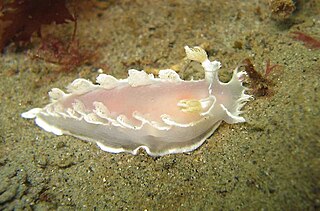
Tritoniidae is a taxonomic family of nudibranchs in the suborder Cladobranchia, shell-less marine gastropod molluscs. This family includes some of the largest known nudibranchs, with the NE Atlantic species Tritonia hombergii reaching 20 cm in length. It is the only family in the monotypic superfamily Tritonioidea.

Tritonicula bayeri is a species of dendronotid nudibranch. It is a marine gastropod mollusc in the family Tritoniidae. A number of Caribbean and western Pacific species of Tritonia were moved to a new genus Tritonicula in 2020 as a result of an integrative taxonomic study of the family Tritoniidae.

Tritonicula hamnerorum is a species of dendronotid nudibranch. It is a marine gastropod mollusc in the family Tritoniidae. A number of Caribbean species of Tritonia were moved to a new genus Tritonicula in 2020 as a result of an integrative taxonomic study of the family Tritoniidae.

Simnialena uniplicata, common name the one-tooth simnia, is a species of sea snail, a marine gastropod mollusk in the family Ovulidae, the ovulids, cowry allies or false cowries. It lives on the sea whip, Leptogorgia virgulata.
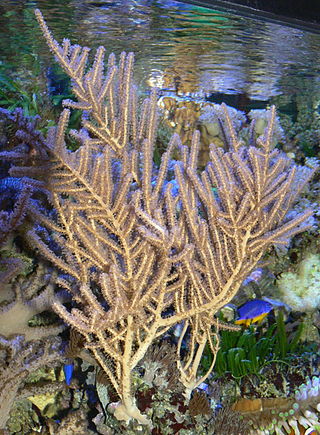
Holaxonia is a suborder of soft corals, a member of the phylum Cnidaria. Members of this suborder are sometimes known as gorgonians and include the sea blades, the sea fans, the sea rods and the sea whips. These soft corals are colonial, sessile organisms and are generally tree-like in structure. They do not have a hard skeleton composed of calcium carbonate but have a firm but pliable, central axial skeleton composed of a fibrous protein called gorgonin embedded in a tissue matrix, the coenenchyme. In some genera this is permeated with a calcareous substance in the form of fused spicules. Members of this suborder are characterized by having an unspiculated axis and often a soft, chambered central core. The polyps have eight-fold symmetry and in many species, especially in the families Gorgoniidae and Plexauridae, contain symbiotic photosynthetic algae called zooxanthellae. These soft corals are popular in salt water aquaria.
Tritonicula wellsi, the sea whip slug, is a species of nudibranch, a shell-less marine gastropod mollusc in the family Tritoniidae. The type locality is Beaufort, North Carolina. A number of Caribbean and western Pacific species of Tritonia were moved to a new genus Tritonicula in 2020 as a result of an integrative taxonomic study of the family Tritoniidae.
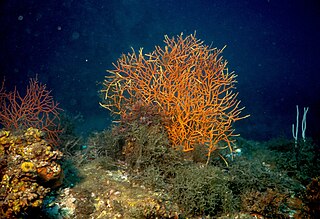
Leptogorgia is a genus of soft coral in the family Gorgoniidae. The genus has a widespread distribution with members being found in the eastern Atlantic Ocean from Western Europe to South Africa, the Mediterranean Sea, the Atlantic coasts of North and South America, the Antilles and the Pacific coast of America. Species are found in both shallow and deep waters.

Leptogorgia hebes, commonly known as the regal sea fan or false sea fan, is a species of soft coral in the family Gorgoniidae. It was formerly included in the genus Lophogorgia but that genus has been dismantled.

Gorgonia ventalina, the common sea fan and purple sea fan, is a species of sea fan, an octocoral in the family Gorgoniidae. It is found in the western Atlantic Ocean and the Caribbean Sea.

Plexauridae is a family of marine colonial octocorals in the phylum Cnidaria. Members of this family are found in shallow tropical and subtropical seas. Many species contain symbiotic photosynthetic protists called zooxanthellae.

Paramuricea clavata, the violescent sea-whip, is a species of colonial soft coral in the family Plexauridae. It is found in shallow seas of the north-eastern Atlantic Ocean and the north-western Mediterranean Sea as well as Ionian Sea. This species was first described by the French naturalist Antoine Risso in 1826.
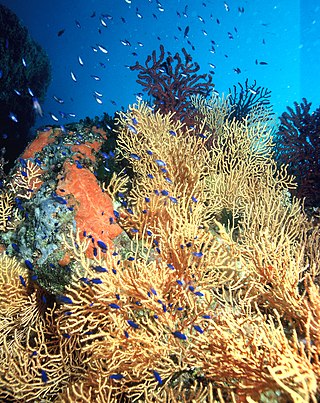
Eunicella cavolini, commonly known as the yellow gorgonian or yellow sea whip, is a species of colonial soft coral in the family Gorgoniidae. It is native to parts of the eastern Atlantic Ocean, Mediterranean Sea and Ionian Sea where it is a common species.

Leptogorgia sarmentosa is a species of colonial soft coral, a sea fan in the family Gorgoniidae. It is native to the eastern Atlantic Ocean and the western Mediterranean Sea, with a single find in the eastern Mediterranean.
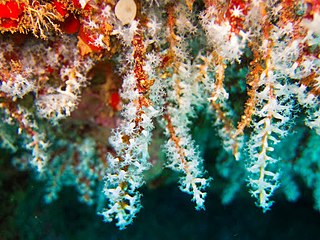
Carijoa riisei, the snowflake coral or branched pipe coral, is a species of soft coral in the family Clavulariidae. It was originally thought to have been native to the tropical western Atlantic Ocean and subsequently spread to other areas of the world such as Hawaii and the greater tropical Pacific, where it is regarded as an invasive species. The notion that it is native to the tropical western Atlantic was perpetuated from the fact that the type specimen, described by Duchassaing & Michelotti in 1860, was collected from the US Virgin Islands. It has subsequently been shown through molecular evidence that it is more likely that the species is in fact native to the Indo-Pacific and subsequently spread to the western tropical Atlantic most likely as a hull fouling species prior to its original description.

Clavularia crassa is a species of colonial soft coral in the family Clavulariidae. It is found in the eastern Atlantic Ocean and the Mediterranean Sea. It was first described in 1848 by the French zoologist Henri Milne-Edwards from a specimen collected off the coast of Algeria.

Conopea galeata is a species of colonial barnacle in the family Archaeobalanidae. It lives exclusively on gorgonians in the western Atlantic Ocean, the Caribbean Sea and the Gulf of Mexico.


















